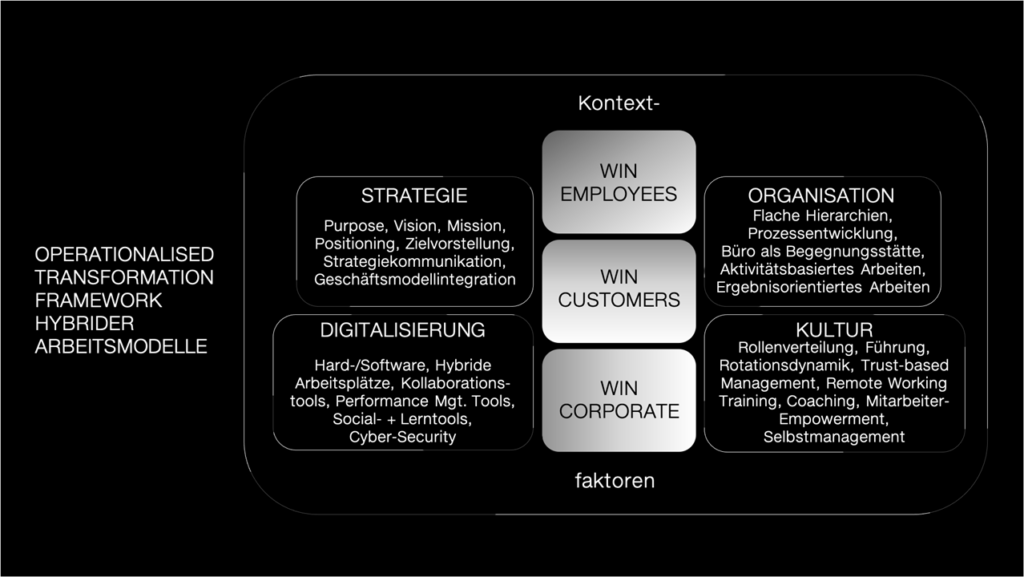
The success factors on the way to the hybrid working world are multifaceted. In this article you will learn how to make the most of your situation as a manager, TeamBring out a leader, CEO or executive in the HR department.
The world is VUCA
In this context, the terms "new work" and "Work 4.0“, which encompass a fundamental transformation in terms of work, leadership and organization, are ubiquitous. The COVID-19 pandemic has accelerated this change by signaling the need for change for companies.
The analysis of planned and unplanned change must always be carried out holistically
um business-relevant transformations, such as the introduction of a hybrid working model, can be carried out in advance in a first conceptual step strategic success factors considered, which are decisive for sustainable success. Changes should always be designed based on the variables that influence success.
simultaneously it is again to analyze centrally, what effects Transformations in individual corporate divisions to other business areas or functions to have. If necessary, areas that are indirectly or directly related to the originally focused transformation will have to undergo a change. This is the only way to ensure that a focused transformation is successful in the long term.
In this respect, a relevant transformation project, regardless of whether it is strongly focused or broader, always requires a holistic, interdependent view. This applies all the more to the sustainable introduction of hybrid working models, as these have a massive impact on the entire company.
Accordingly, hybrid working models are both drivers and driven of the transformation.
The question that first arises when analyzing transformation projects and thus also when implementing hybrid working models in a sustainable manner is the following. Which dimensions can we use to view and evaluate the planned transformation? So specifically: Which areas need to be analyzed and considered directly and indirectly in order to be able to optimally implement the focused or broader transformation project?

The sustainable implementation of hybrid working models is a central task of top management
Prof. Dr. Frank Keuper
The main task of top management is to coordinate the mutually influencing strategic transformation parameters in a way that is appropriate to the target Strategy, organization, technology and culture. In the course of the current primacy of digital technologies with regard to corporate success, the focus in strategic corporate management, within the framework of the technology dimension, is on the Digitalization placed.
The corporate strategy Expresses how the company's goals are to be achieved. At the same time, the code of conduct specifies how the formal Organization and the Digitalization can be transformed into concrete behavioral options. This only leads to corporate success if the Corporate Culture Expressive informal rules and structures ensure a purpose-oriented, and thus target and strategy-compliant, willingness to behave on the part of employees and managers.
Transformation Framework
In the sense of one closed transformation approach so it is essential, either consistency between four design parameters as well as most congruence between these parameters and the situational context factors to protect.

In this respect, when introducing and designing hybrid working models, their effects on the areas of strategy, organization, digitization and culture must be recorded and adjustments made there if necessary. At the same time, one can pay attention to hybrid working models from the perspective of the four strategic action parameters. The aim is to ensure that the working model is designed according to the four "dimension specifications". This is the only way hybrid working models can lead to one Win-win-win situation for employees, customers and the company.
We were able to get both our generic transformation framework as well as ours Transformation framework for hybrid working models within the framework of our project experience and with the help of qualitative and quantitative studies carried out by us.

The future of the working world is hybrid, not digital
According to a study by the Boston Consulting Group (BCG), the changing world of work - amplified by the COVID-19 pandemic - has reached many companies. Compared to 2019, the offer of flexible work policies by companies increased from 2020 percent to 15 percent in 68 (Ferreira, José; Claver, Pablo, Pereira, Pedro and Thomaz, Sebastiao. “Remote Working and the Platform of the Future. “ Boston Consulting Group, October 10, 2020).
The hybrid world of work ⎼ a curse or a blessing
The hybrid form of work not only poses challenges for employees and managers, but also for employers. Increasing job satisfaction and higher motivation among employees in connection with the opportunity to reconcile professional and private life are faced with the difficulty of separating professional and private life. In addition, there is increased mental stress due to growing personal responsibility and the danger of isolation and loneliness.
As part of our project experience and with the help of qualitative and quantitative studies we carried out ourselves, we were also able to identify the strategic success factors of our Transformation frameworks for hybrid working models further operationalize.
One input for us was the study “Remote Working and the Platform of the Future” by the Boston Consulting Group (Ferreira, José; Claver, Pablo, Pereira, Pedro and Thomaz, Sebastiao. “Remote Working and the Platform of the Future.” Boston Consulting Group, October 10, 2020). The path to hybrid work is explained there on the basis of seven, but little-founded, dimensions.
But as stated at the beginning, it is unavoidable in terms of a closed implementation approach for hybrid working models, both the consistency between the four design parameters strategy, organization, digitization and corporate culture as well as the congruence between these parameters and the situational context factors.

The success factors on the way to the hybrid working world are:
1. The Strategy – New Work – connection
As part of the strategic consideration, you define the Employee-, Customer and company goals, which one would like to achieve with a hybrid working model (e.g.: "Increasing employee satisfaction", "More flexible customer orientation" and "Increasing the ability to innovate"). The question to be clarified is how to design the combination of home office, remote work and presence.
From the corporate purpose, if available, the The reason for promoting hybrid work is understandable being. You can also use the pressure to implement hybrid working models sustainably to use the idea of hybrid working as a fragment for the design of the corporate purpose.
Of course the defined ones are Goals with the corporate strategy to vote and into that integrate business model. This point creates clarity for all employees about the strategy and the associated goals, demonstrates the commitment to the changes. In addition, he motivates the entire organization in its efforts to achieve the goals.
2. The Organization – New Work – connection
Require hybrid working models new structuresthat enable employees to be creative and productive in ways that make most sense to them. Requires one goal-oriented work, where that result in focus stands.
Flat hierarchies are a GOT TO for the successful implementation of hybrid working models to enable fast, flexible, employee-oriented and appreciative communication. Due to the physical distance and the associated difficulties in communication, Employees have the freedom to make decisions.
In the first step, a review of activities take place to evaluate which tasks require personal attendance and which can be done virtually. In a next step, the productivity measurement processes can be restructured and the reporting structures adjusted.
In the context of the new hybrid work organization, this wins Office a whole new meaning. The office must as motivating and emotional meeting place act. Teams need meeting and conference rooms that need to be redesigned. The goal is to provide resilient office space.
These can be flexibly adapted by employees to their needs. Here it says activity-based work in the foreground. This work style allows employees to choose from a variety of work environments based on their current needs.
3. The culture - new work - connection
To ensure a WIN-WIN-WIN situation for everyone involved, the Corporate culture in focus to deliver. companies need one hybrid corporate culture, in order to be able to live hybrid working models at all. A trust-based culture of appreciation and openness is essential.
Hybrid working models require a new one hybrid leadership style. This forms the bridge between the analogue and digital working worlds. Managers must ensure that Equal opportunities between employees in the office and at remote locations. This management style takes into account the changing needs of employees, and involves managers changing their behavior individually tailored to their employees and the working environment.
The ability to understand the needs of employees despite physical distance and a virtual social intimacy build characterizes the new role of leaders. Managers have been spoken of as mentor and coach for years, now the time has come – “Butter by the fish”.
Obstacles that stand in the way of employees must be cleared away. Control must be relinquished and a trusting attitude adopted instead. This increases productivity, promotes motivation and creativity and allows the ability to innovate to flourish.
The balance between virtuality and presence requires new rules of cooperationto counter possible feelings of anonymity and declining company identification ex ante. Emotional topics require a personal conversation. Division of work, on the other hand, can take place virtually. In addition, you can develop virtual formats to replace personal encounters in the office and continue to do so Teamto maintain feeling. That too Employee self-management can be promoted in order to master psychological challenges.
4. The Digitization – New Work – connection
The Provision of the latest digital systems and tools is essential in order to be able to live a hybrid working model. The latest digital technologies imply location-independent control and implementation of activities and processes as well as virtual performance measurement and administration. It goes without saying that the employees have comprehensive hardware and software equipment for home and mobile use. But even more important is the provision of state-of-the-art digital technologies that Interaction and Collaboration between the employees as if they were present in the office or with the customer.
The conclusion on the success factors on the way to the hybrid working world
New Work and hybrid working models are part of corporate transformation. transformation means change through critical reflection NEW zu START, the THE STATUS QUO zu TO CHANGE and BUSINESS zu EXPAND.
Hybrid: working models are at the same time driver and Driven the transformation. As a transformation fractal, hybrid working models require a holistic Considerationto ensure implementation success.
Strategy, Organization, Digitalization and Corporate Culture there is Top management transformation parameters and cornerstones transformation architecture - are massively influenced by the implementation of hybrid working models and in turn influence the design and success of hybrid working models.
Ultimately, the sentence by Frank Zappa quoted at the beginning applies: ONE SIZE DOES NOT FIT ALL.
If you would like to know more about the success factors on the way to the hybrid working world, ask us. We are always there for you!
Hybrid working models combine elements of remote work and face-to-face work and offer employees the flexibility to work from different locations. Implementing a hybrid working model requires careful planning and clear communication with employees to ensure everyone involved understands and meets expectations. It may also be necessary to provide technical resources and training to facilitate working from home. It is also important to encourage employees to develop productive work practices and to maintain collaboration and communication.
Hybrid working models offer both employers and employees advantages and disadvantages. Benefits for employers include increased employee satisfaction and retention, increased productivity and efficiency, and better use of resources such as office space. Employees can benefit from a better work-life balance and more flexibility. Disadvantages include poorer collaboration and communication, and possible deterioration of the Teammental. Workers may also have difficulties in separating work and private life and finding a suitable job.
In order to be successful in a hybrid working model and to achieve a good work-life balance, employees should take a few important steps. This includes setting up a suitable workspace at home, creating clear boundaries between work and personal life, developing a productive work routine, maintaining good communication with colleagues and supervisors, and maintaining a healthy work-life balance. It is also important to receive regular feedback from colleagues and supervisors to ensure that work products are as expected and to make adjustments where necessary to improve the quality of work.
